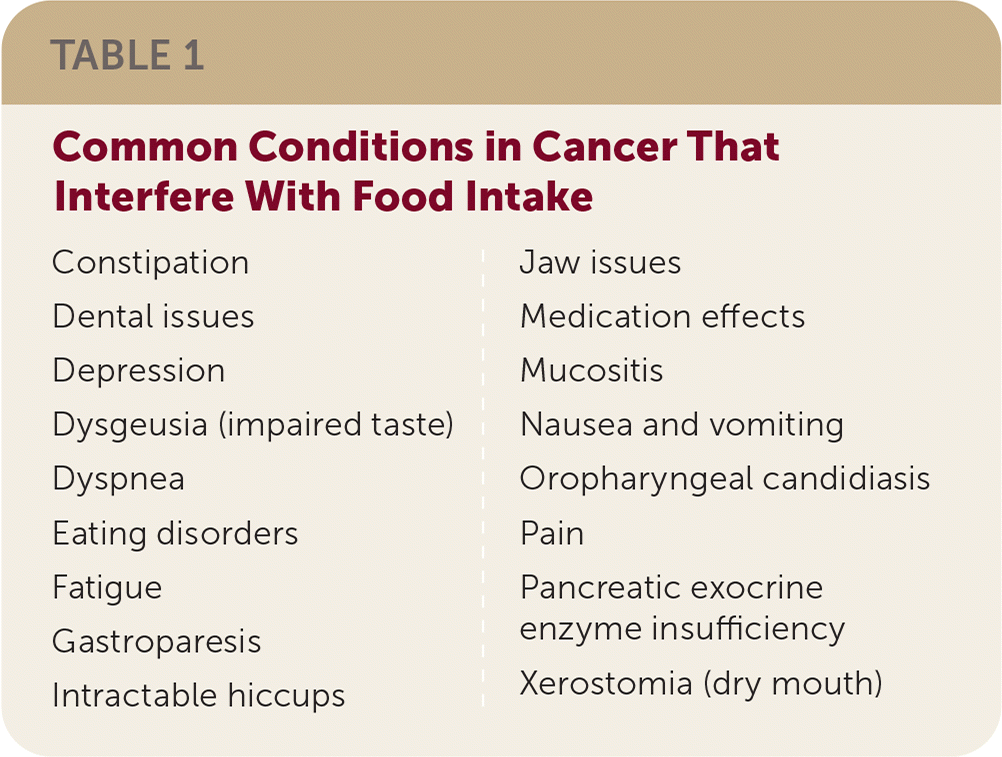
Am Fam Physician. 2022;106(1):102-103
Author disclosure: No relevant financial relationships.
| • Monitoring and addressing distress in patients with cancer and their caregivers are fundamental aspects of palliative care. |
| • Anticancer therapy can be an element of palliative care, although benefits are unlikely when cancer is progressive and metastatic. |
| • Adding nonpharmacologic therapies including massage and art or music therapy to medications improves pain and mood. |
| • Although cachexia is common in advanced cancer, evaluating for treatable causes can be helpful. |
| From the AFP Editors |
In 2021, nearly 2 million Americans were diagnosed with cancer and more than half a million died from the disease; rates are increasing worldwide. More than one-third of people experience at least moderate pain, nausea, anxiety, dyspnea, drowsiness, anorexia, and fatigue in their last weeks of life. Multiple organizations recommend integrating palliative care into cancer treatment from the time of diagnosis. The National Comprehensive Cancer Network (NCCN) has updated recommendations for palliative care of patients with cancer.
Palliative Care
Palliative care focuses on patient-and family-centered care to manage distressing symptoms, psychosocial health, and spiritual care to reduce suffering. It promotes adaptive coping strategies, which focus on identifying and addressing problems rather than avoiding the issues.
Patients and their caregivers sometimes have unrealistic expectations of treatment, and correcting these misperceptions can increase distress. Providing coping strategies with prognostic awareness may reduce distress in patients who accurately understand their disease as incurable.
Assessing Distress
Distress is the umbrella term for the physical, psychological, social, and spiritual issues that interfere with the patient’s ability to cope effectively with cancer and its treatment. The term distress encompasses the multifactorial nature without the stigma of psychiatric terms. The NCCN recommends assessing distress on a 10-point scale between no distress and extreme distress.
Patients and caregivers should be assessed for distress. Loss of employment is a common source of distress because it can lead to a loss of purpose, increased social isolation, and financial anxiety. Promotion of adaptive coping mechanisms is a primary means of addressing distress, although psychological and financial support are often also required.
Anticancer Therapy
Anticancer treatments are an element of palliative care, as long as they continue to be consistent with patient goals, and are provided with symptom management interventions. In advanced cancer, anticancer treatments are less effective. For instance, in patients with progressive metastatic cancer, palliative chemotherapy may fail to improve quality of life, and if the patient is initially robust, quality of life could worsen.
Symptom Management
Palliative care depends on regularly assessing symptoms in addition to distress. In noncommunicative patients, physical signs may be the only indication of symptom intensity. These assessments should include family and caregivers affected by the patient’s symptoms and distress.
PAIN
Although addressing pain is essential for cancer care, pain management must be balanced against its effects on level of consciousness and activity. In advanced cancer, aggressive pain management with an opioid may be needed. Palliative radiotherapy can address pain from bone metastases. Palliative sedation remains an option for refractory pain.
Adding nonpharmacologic therapy to medications for pain improves physical symptoms and mood. Cognitive behavior therapy, acceptance and commitment therapy, massage, and art and music therapy all have evidence of benefit.
ANOREXIA AND CACHEXIA
Cachexia is physical wasting that is common with advanced cancer. Although anorexia often contributes, muscle proteolysis due to pro-inflammatory cytokines and tumor-derived factors is often the primary cause of cachexia. Muscle depletion is associated with poor prognosis independent of body mass index and reduces the effectiveness of treatment while increasing toxicity.
Addressing weight loss involves looking for a treatable condition that limits food intake (Table 1). A formal swallowing evaluation should be considered if there is any sign of a swallowing dysfunction. Discontinuing medications that affect appetite and improving the bowel regimen can help. Nutrition counseling and social support can also be beneficial.

| Constipation Dental issues Depression Dysgeusia (impaired taste) Dyspnea Eating disorders Fatigue Gastroparesis Intractable hiccups | Jaw issues Medication effects Mucositis Nausea and vomiting Oropharyngeal candidiasis Pain Pancreatic exocrine enzyme insufficiency Xerostomia (dry mouth) |
Appetite stimulants are only recommended if an increased appetite will improve quality of life. Although megestrol (Megace) improves appetite and leads to mild weight gain, benefits are limited by increased risk of venous thromboembolism, fluid retention, and death. Olanzapine (Zyprexa) may be considered as an alternative, with dexamethasone or cannabinoids when life expectancy is limited. Mirtazapine (Remeron) may be beneficial when depression and anxiety are present. If gastroparesis is present, metoclopramide (Reglan) may be considered.
DYSPNEA
Shortness of breath is primarily treated with morphine for air hunger and lorazepam (Ativan) for anxiety. Use of both medications may be limited by sedation, but rapid titration may be required for acute progressive dyspnea.
EXCESSIVE SECRETIONS
Near end of life, excessive secretions can be treated with scopolamine patches, sublingual ophthalmologic atropine drops, or glycopyrrolate given intravenously or subcutaneously.
The views expressed are those of the author and do not necessarily reflect the official policy or position of the Department of the Navy, Uniformed Services University of the Health Sciences, Department of Defense, or the U.S. government.
Editor's Note: Because nearly 1 in 200 Americans is a cancer survivor, we routinely treat these patients. As with geriatricians, the number of palliative care specialists to take this responsibility from family physicians is insufficient. The NCCN publishes treatment guidelines for specific cancers and common issues within cancer; this palliative care guideline includes many of the common issues. Routinely assessing distress in patients and caregivers is a simple intervention that can ensure we stay focused on holistic family care.—Michael J. Arnold, MD, Contributing Editor
Guideline source: National Comprehensive Cancer Network
Evidence rating system used? No
Systematic literature search described? Yes
Guideline developed by participants without relevant financial ties to industry? Yes
Recommendations based on patient-oriented outcomes? Yes
Published source: J Natl Compr Canc Netw. July 2021;19(7):780–788
